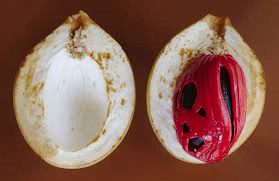Mace is one of the most intriguing spices, known for its delicate, floral aroma and warm, spicy flavour. Often overshadowed by its close relative, nutmeg, mace offers a unique twist in the world of culinary spices. Let’s explore this fascinating spice, its uses, and its rich history.
What Is Mace?
Mace is the dried outer covering (or aril) of the nutmeg seed, harvested from the Myristica fragrans tree, which is native to Southeast Asia. The vibrant red, lace-like aril surrounds the nutmeg seed and, once dried, turns a yellow-orange colour. The result is a spice that is both aromatic and slightly peppery, with hints of cinnamon, clove, and nutmeg itself.
A History of Mace
Mace has a long and storied history. Like nutmeg, it was highly prized by European traders during the 16th and 17th centuries, a time when the spice trade was a major driver of exploration. The Dutch and Portuguese fought fiercely for control of the Spice Islands, where nutmeg and mace were cultivated. Mace was once considered more valuable than nutmeg because of its delicate flavour and scarcity.
How Does Mace Taste?
Mace has a warm, slightly sweet flavour that is a bit more delicate than nutmeg. It’s spicy, with hints of pepper and a light, floral note. Mace is often described as more delicate and aromatic than nutmeg, with a smoother, less pungent taste. Its sweet-spicy balance makes it a versatile addition to both sweet and savoury dishes.
Culinary Uses of Mace
Mace is a versatile spice that can be used in a variety of dishes, from desserts to curries. Here’s how you can incorporate it into your cooking:
- Baked Goods: Mace is often used in baking, adding depth to cakes, cookies, and pies. It pairs particularly well with cinnamon and nutmeg in spiced cakes and pastries.
- Soups and Stews: It can be used in soups and stews to add a warm, aromatic kick. Mace works particularly well in creamy or rich dishes, such as chowders or pumpkin soup.
- Curries and Rice Dishes: Mace is a key ingredient in many Indian and Middle Eastern spice blends. It adds a subtle heat to curries, rice pilafs, and biryanis.
- Beverages: Mace can be used in hot beverages like mulled wine or spiced tea for a comforting, fragrant twist.
- Savory Dishes: Mace can also be added to meat dishes, particularly those made with chicken or lamb, and in sauces like béchamel.
Health Benefits of Mace
Mace has long been used in traditional medicine for its therapeutic properties:
- Digestive Aid: Mace can help alleviate digestive issues such as bloating, indigestion, and nausea.
- Anti-inflammatory: The compounds in mace have anti-inflammatory properties, making it useful for easing conditions like arthritis.
- Mood Enhancer: Mace is believed to have mood-boosting properties and may help relieve stress or anxiety.
- Antioxidants: Like other spices, mace is rich in antioxidants, which help to fight free radicals and support overall health.
How to Use Mace
- Use Ground Mace: Mace is often sold ground, making it easy to sprinkle into dishes. However, freshly grated mace can have a more intense flavour.
- Add it to Spice Blends: Mace pairs beautifully with other warm spices like cinnamon, nutmeg, and cloves. Mix it into spice blends for cakes, cookies, or savoury dishes.
- Infuse in Liquids: To extract the full flavour, you can infuse mace into milk, cream, or stock, then strain it out before using.
Fun Fact: Mace vs Nutmeg
Although nutmeg and mace come from the same fruit, they have distinct flavours. Nutmeg is more robust and pungent, while mace is milder and more aromatic. When used together, they complement each other, creating a well-rounded spice profile in both sweet and savoury dishes.
Precautions
While mace is generally safe for most people, it’s important to use it in moderation. Consuming large amounts of mace may cause digestive discomfort or, in rare cases, toxicity. Pregnant women should avoid excessive use of mace, as it may stimulate uterine contractions.
Conclusion
Mace may be the lesser-known sibling of nutmeg, but it’s a spice worth getting to know. Its delicate yet bold flavour can enhance a wide range of dishes, from sweet treats to savoury meals. Whether you’re baking, cooking, or sipping a warm beverage, mace can add a fragrant, spicy twist that’s sure to impress.
Have you ever cooked with mace? Let us know how you use this versatile spice in your kitchen!

